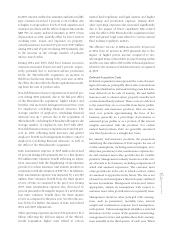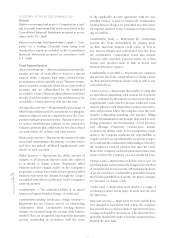American Express 2004 Annual Report Download - page 61
Download and view the complete annual report
Please find page 61 of the 2004 American Express annual report below. You can navigate through the pages in the report by either clicking on the pages listed below, or by using the keyword search tool below to find specific information within the annual report.
In 2003, interest credited on annuities and universal life
type contracts increased 6 percent to $1.2 billion due
to higher average inforce levels of both annuities and
insurance products and the effect of appreciation in the
S&P 500 on equity indexed annuities in 2003 versus
depreciation in 2002, partially offset by lower interest
crediting rates. Losses and expenses on property-
casualty insurance increased 27 percent to $327 million
during 2004 and 45 percent during 2003 primarily due
to the increase in the average number of policies
inforce noted earlier.
During 2004 and 2003, field force human resources
expenses increased 25 percent and 9 percent, respec-
tively, primarily due to increased advisor production
levels, the Threadneedle acquisition, an increase in
field force headcount during both years and, in 2004,
the effect of reduced levels of DAC capitalization result-
ing from the mix of product sales.
Non-field human resources expenses increased 26 per-
cent during 2004 primarily due to the full-year effect
of the Threadneedle acquisition, higher salaries and
benefits, and increased management incentives costs
for employees (excluding financial advisors). The
average number of employees (excluding financial
advisors) was up 7 percent due to the acquisition of
Threadneedle; excluding the Threadneedle impact, the
average number of employees was level with 2003.
Non-field human resources expenses increased 22 per-
cent in 2003, reflecting merit increases and greater
employee benefit and management incentive costs for
employees (excluding financial advisors), as well as
the effect of the Threadneedle acquisition.
DAC amortization expense of $405 million decreased
15 percent during 2004 primarily due to a first quarter
$66 million DAC valuation benefit reflecting an adjust-
ment associated with the lengthening of amortization
periods for certain insurance and annuity products in
conjunction with the adoption of SOP 03-1. In addition,
DAC amortization expense was impacted by a net $22
million DAC valuation benefit from the third quarter
review of DAC as compared to the prior year. During
2003, DAC amortization expense also decreased 15
percent primarily reflecting the impact of a net $46 mil-
lion DAC valuation benefit from the third quarter
review as compared to the prior year. See the DAC sec-
tion below for further discussion of DAC and related
2004 and 2003 adjustments.
Other operating expenses increased 30 percent to $1.2
billion reflecting the full-year impact of the Thread-
needle acquisition, higher costs related to various
mutual fund regulatory and legal matters and higher
advertising and promotion expense. During 2003,
other operating expenses also increased significantly
due to the impact of fewer capitalized DAC-related
costs, the effect of the Threadneedle acquisition in late
2003 and greater legal costs related to various mutual
fund industry regulatory matters.
The effective tax rate at AEFA increased to 26 percent
in 2004 from 21 percent in 2003 primarily due to the
impact of higher pretax income compared to tax-
advantaged items, reduced low income housing credits
and the one-time effect of favorable technical guidance
related to the taxation of dividend income recognized
in 2003.
Deferred Acquisition Costs
Deferred acquisition costs represent the costs of acquir-
ing new business, principally direct sales commissions
and other distribution and underwriting costs that have
been deferred on the sale of annuity, life and health
insurance and, to a lesser extent, property/casualty and
certain mutual fund products. These costs are deferred
to the extent they are recoverable from future profits.
For annuity and insurance products, DAC are amor-
tized over periods approximating the lives of the
business, generally as a percentage of premiums or
estimated gross profits or as a portion of the interest
margins associated with the products. For certain
mutual fund products, DAC are generally amortized
over fixed periods on a straight-line basis.
For annuity and insurance products, the projections
underlying the amortization of DAC require the use of
certain assumptions, including interest margins, mor-
tality rates, persistency rates, maintenance expense lev-
els and customer asset value growth rates for variable
products. Management routinely monitors a wide vari-
ety of trends in the business, including comparisons of
actual and assumed experience. The customer asset
value growth rate is the rate at which contract values
are assumed to appreciate in the future. The rate is net
of asset fees and anticipates a blend of equity and fixed
income investments. Management reviews and, where
appropriate, adjusts its assumptions with respect to
customer asset value growth rates on a quarterly basis.
Management monitors other principal DAC assump-
tions, such as persistency, mortality rates, interest
margin and maintenance expense level assumptions,
each quarter. Unless management identifies a material
deviation over the course of the quarterly monitoring,
management reviews and updates these DAC assump-
tions annually in the third quarter of each year. When
AXP
AR.04
59
Financial Review
























